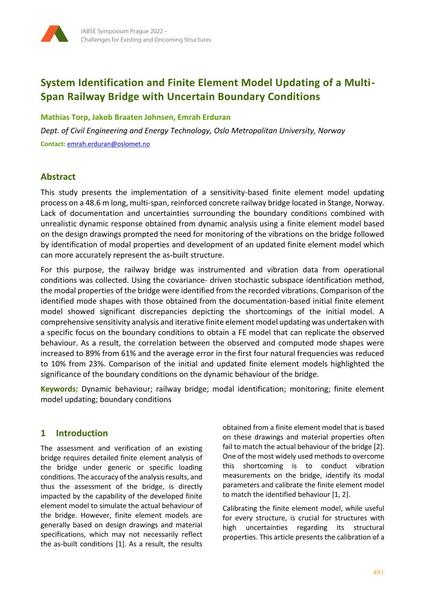System Identification and Finite Element Model Updating of a Multi- Span Railway Bridge with Uncertain Boundary Conditions

|
|
|||||||||||
Bibliografische Angaben
| Autor(en): |
Mathias Torp
(Dept. of Civil Engineering and Energy Technology, Oslo Metropolitan University, Norway)
Jakob Braaten Johnsen (Dept. of Civil Engineering and Energy Technology, Oslo Metropolitan University, Norway) Emrah Erduran (Dept. of Civil Engineering and Energy Technology, Oslo Metropolitan University, Norway) |
||||
|---|---|---|---|---|---|
| Medium: | Tagungsbeitrag | ||||
| Sprache(n): | Englisch | ||||
| Tagung: | IABSE Symposium: Challenges for Existing and Oncoming Structures, Prague, Czech Republic, 25-27 May 2022 | ||||
| Veröffentlicht in: | IABSE Symposium Prague 2022 | ||||
|
|||||
| Seite(n): | 491-498 | ||||
| Anzahl der Seiten (im PDF): | 8 | ||||
| DOI: | 10.2749/prague.2022.0491 | ||||
| Abstrakt: |
This study presents the implementation of a sensitivity-based finite element model updating process on a 48.6 m long, multi-span, reinforced concrete railway bridge located in Stange, Norway. Lack of documentation and uncertainties surrounding the boundary conditions combined with unrealistic dynamic response obtained from dynamic analysis using a finite element model based on the design drawings prompted the need for monitoring of the vibrations on the bridge followed by identification of modal properties and development of an updated finite element model which can more accurately represent the as-built structure. For this purpose, the railway bridge was instrumented and vibration data from operational conditions was collected. Using the covariance- driven stochastic subspace identification method, the modal properties of the bridge were identified from the recorded vibrations. Comparison of the identified mode shapes with those obtained from the documentation-based initial finite element model showed significant discrepancies depicting the shortcomings of the initial model. A comprehensive sensitivity analysis and iterative finite element model updating was undertaken with a specific focus on the boundary conditions to obtain a FE model that can replicate the observed behaviour. As a result, the correlation between the observed and computed mode shapes were increased to 89% from 61% and the average error in the first four natural frequencies was reduced to 10% from 23%. Comparison of the initial and updated finite element models highlighted the significance of the boundary conditions on the dynamic behaviour of the bridge. |
||||
| Stichwörter: |
dynamisches Verhalten Monitoring
|
||||
| Copyright: | © 2022 International Association for Bridge and Structural Engineering (IABSE) | ||||
| Lizenz: | Die Urheberrechte (Copyright) für dieses Werk sind rechtlich geschützt. Es darf nicht ohne die Zustimmung des Autors/der Autorin oder Rechteinhabers/-in weiter benutzt werden. |
||||
